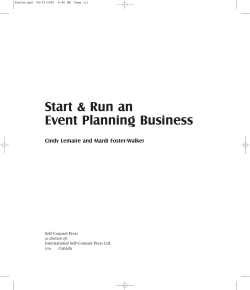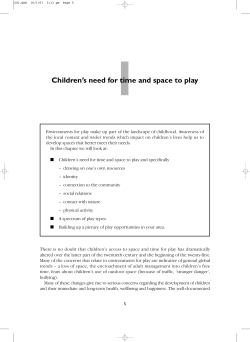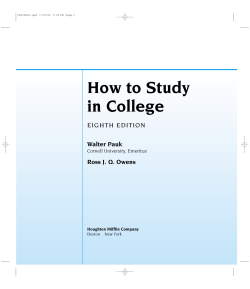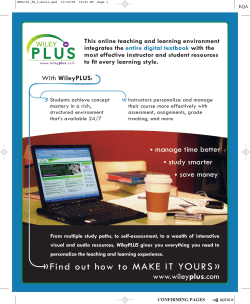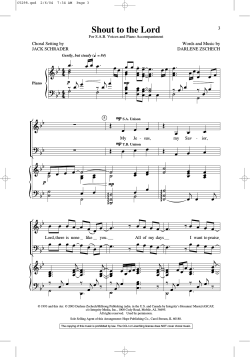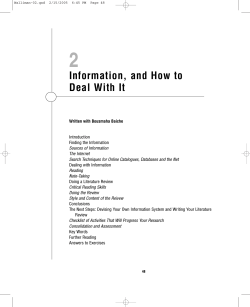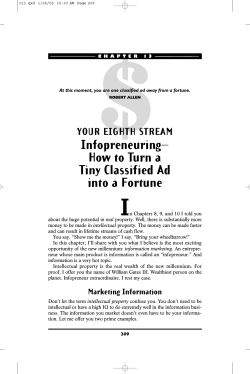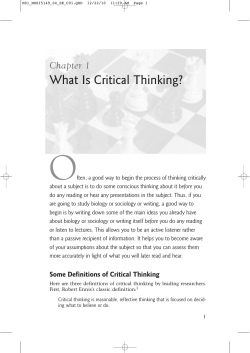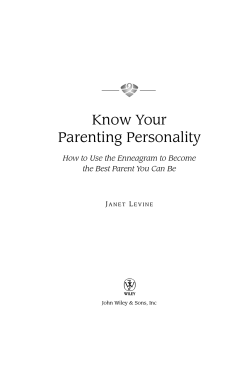
A How-to Guide for Teaching English Language Learners In the Primary Classroom
ch00_4458.qxd 8/11/05 1:09 PM Page iii A How-to Guide for Teaching English Language Learners In the Primary Classroom Pat Barrett Dragan HEINEMANN Portsmouth, NH ch00_4458.qxd 8/11/05 1:09 PM Page iv Heinemann A division of Reed Elsevier Inc. 361 Hanover Street Portsmouth, NH 03801–3912 www.heinemann.com Offices and agents throughout the world © 2005 by Pat Barrett Dragan All rights reserved. No part of this book may be reproduced in any form or by any electronic or mechanical means, including information storage and retrieval systems, without permission in writing from the publisher, except by a reviewer, who may quote brief passages in a review, with the following exception: Appendix (on pages 199 through 224) may be photocopied for classroom use only. The author and publisher wish to thank those who have generously given permission to reprint borrowed material: “In the Museum” from Everything Glistens and Everything Sings: New and Selected Poems by Charlotte Zolotow. Copyright © 1987 by Charlotte Zolotow. Reprinted by permission of Harcourt, Inc. Library of Congress Cataloging-in-Publication Data Barrett Dragan, Patricia. A how-to guide for teaching English language learners : in the primary classroom / Pat Barrett Dragan. p. cm. Includes references and index. ISBN 0-325-00700-4 (alk. paper) 1. English language—Study and teaching (Primary)—Foreign speakers. I. Title. PE1128.A2B314 2005 372.652′1044—dc22 2005016361 Editor: Lois Bridges Production editor: Sonja S. Chapman Cover design: Night & Day Design Compositor: Publishers’ Design and Production Services, Inc. Manufacturing: Jamie Carter Cover photograph: Alfonso Alvarez, grade 1, and Tatiana Alvarez, grade 5, taken by Pat Barrett Dragan Printed in the United States of America on acid-free paper 09 08 07 06 05 ML 1 2 3 4 5 ch00_4458.qxd 8/11/05 1:09 PM Page vii C O N T E N T S Acknowledgments Introduction xi CHAPTER CHAPTER CHAPTER CHAPTER CHAPTER CHAPTER CHAPTER CHAPTER CHAPTER CHAPTER CHAPTER CHAPTER ix 1 Looking Through the Eyes of Second Language Learners 1 2 Structuring the Classroom Environment to Propel English Learners Toward Success 24 3 Demystifying Second Language Acquisition 36 4 Getting Started Teaching ELLs—A Look at the First Twenty Days of School 47 5 Exciting Ways to Get Children Talking 58 6 Facilitating Oral Language Acquisition Through Poetry and Music 80 7 Using Shared Reading and Picture Books to Help Children Acquire Language and Learn to Read 99 8 Enriching Language Learning Through Language Arts and Visual Arts Connections 112 9 Thematic Teaching: Making Connections 126 1 0 Writing and Publishing with English Language Learners 155 1 1 Putting It All Together with Puppetry, Masks, and Drama 175 1 2 Connecting with Families 188 vii ch00_4458.qxd 8/11/05 1:09 PM viii Contents Page viii Appendix 199 “I Like” Self-Portrait Template 200 Interview Grid 201 Thought Balloon 202 Celebration Banners 203 “Who Took the Cookie from the Cookie Jar?” Booklet Template 204 Hundreds Day Kites 205 Kite Pattern 207 Artistic License 208 Scene or Museum Boxes 209 Poetry Frame 211 Mandala 212 “I Was Born to” Booklet Template 213 K-W-L Chart 214 Web Template 1 215 Web Template 2 216 Leaf Prints 217 Eight-Page Booklets 219 Eight-Page Pop-Up Books 220 Simple Hand Puppets 221 Cup Theater or Habitat with Puppets 222 Mask Template 223 Masks 224 Resources and References 225 Index 249 ch04_4458.qxd 8/11/05 1:26 PM Page 47 C H A P T E R Getting Started Teaching ELLs—A Look at the First Twenty Days of School (And then Twenty More and Twenty More and . . .) Marianthe knew this day would come. [The first day of school in a new land.] “I won’t know anyone . . . I won’t understand what they say. They won’t understand me,” she said. “Everything is so different.” “Only on the outside,” said Mama. “Inside, people are the same.” —Aliki, Marianthe’s Story: Painted Words, Spoken Memories Starting school in a new grade can cause anxious moments for many children. The trip into a new classroom can be much more difficult for a child who doesn’t speak the language and more difficult yet for children coming from another country. Things may be the most difficult of all for the limited English speakers who enter class after the year begins. All eyes are on them as they join an already-established community of learners. There are many things we can do right away to help children feel welcome and comfortable and to help them believe they are a valued part of our classroom community. It doesn’t take a lot of specialized materials and equipment to make this happen. Top on my list of strategies is to be aware of the child’s body language and facial expressions; to smile; and to try to be as nurturing, helpful, and sensitive as possible. I also get some help from my students. 47 4 ch04_4458.qxd 8/11/05 1:26 PM 48 A How-to Guide for Teaching English Language Learners Page 48 A Friend in Need The first thing your new English learner needs is a buddy. Since most of my students are English learners, everybody gets a buddy. I try to seat students so that a buddy who speaks their language is seated on one side of them. Children who have less proficiency in English get a second buddy on the other side—if possible, a child who speaks both English and the English learner’s home language. Depending on the needs of children and their patience level, I pair children with more language capability with children who have an average and an above average command of language. I match students with middle-level language development with those children in need of more help with language. I try to pair children who like each other. These partner decisions also take into account the personalities of individual students. At times no one else speaks a new student’s native tongue. I make sure this child gets a really competent, nurturing buddy who can patiently show her how to do things. Later I will try to get help from someone—a parent volunteer or tutor—who speaks both the child’s home language and English. If I know about a child’s language needs before school starts, I try to arrange for a parent volunteer or cross-age tutor from another classroom before the opening bell rings. It is important to model for the class ways that buddies can help each other. Children need to speak clearly and look at their partners as they speak. They can show their partners what they should be doing, point to the page number, demonstrate what to do with materials, and so on. It is crucial that children are patient and show respect for their partners. It can be tricky expecting young children to translate information correctly and patiently, but they really can be quite helpful to newcomers and to children who do not understand much English. Many of these children have already spent a lot of time translating for their parents or siblings and have a lot of experience in this area. Buddies can help their partners learn classroom routines and show them what they need to be working on. Early in the school year, what could be called copying from someone else’s paper is perfectly acceptable: it is a way for new students to participate and begin to learn. Last year I had an English learner who copied feverishly at the beginning of the term. I think this allowed her to feel that she was a participating, authentic member of our class. Like everyone else, she was busy! Later in the year, I tried to limit her copying so that she could use and rely on some of her own knowledge. ch04_4458.qxd 8/11/05 1:26 PM Page 49 How to Make the Best Use of Buddies Here is a list of ways buddies can help their English learner partners: 49 Getting Started Teaching ELLs— ■ Show their partners the work to be done ■ Answer questions and give reassurance ■ Read a story or part of a story ■ Point out or demonstrate the classroom routine to be followed, such as stand up, go to the meeting place on the rug, or turn to page 3 for reading in unison ■ Point to words being read when the class reads a poem or piece of literature together ■ Help the English learner practice the alphabet song, alphabet letters, numbers, and simple vocabulary ■ Show how to practice counting in English ■ Play simple word games ■ Show their partners how to get lunch and get settled in the cafeteria ■ Play with partners (at least for a few minutes at break time) and teach them how to participate in recess activities ■ Join buddies at the listening center: help with tapes and finding the printed words that match those heard on the tape ■ Help partners learn to communicate by sharing a few simple words ■ Learn some words in their partners’ language ■ Work together at centers ■ Work together on art projects; play art games (see Chapter 1, page 17, for sample games) ■ Talk with partners and share recreational reading books together (see Figure 4–1) As teachers, we need to be on top of the buddy situation by checking frequently to see whether partner pairs are working out. Some pairings may need to be changed if the helper seems drained by the experience or if children seem tense and annoyed with each other. And occasionally we may find children who prefer to work alone and would rather not A Look at the First Twenty Days of School ch04_4458.qxd 8/11/05 1:26 PM Page 50 Figure 4–1 Marco and Martin give Kevin a boost by listening to him read. have a buddy. It is important to honor this need and to allow these students to work with a buddy part-time if they change their mind. I think it is essential to change partners every six or eight weeks to keep children from becoming too dependent on each other. Some children also need a break from their buddy partners. Parent Volunteers and Cross-Age Tutors 50 It can be helpful to have parent volunteers or cross-age tutors for children with little or no home language support in the classroom. It is reassuring for them to have at least one person with whom they can communicate! Naturally a parent volunteer or older student from another class (cross-age tutor) cannot be present all the time. But even having one around for a few minutes a few times a week can be helpful. It is best if there is a regular schedule so that the student in need of help can rely on it. One of the jobs a parent volunteer can do before school begins is to make a cassette for a new student that gives information about the school and the class in the child’s home language. This cassette should include school rules and information about what is expected in the classroom as well as specifics about bathrooms and fire drills. A nice touch is to include some music or poetry or a story in the child’s home language. ch04_4458.qxd 8/11/05 1:26 PM Page 51 This can be a helpful present for your new English learner on the first day of school. If you are able to borrow an older student for a few brief minutes on day one, it would be helpful if he could translate directions, answer questions, and be sure the child understands where bathrooms are and when to use them, knows about emergency drills, and so on. Of course, if this isn’t possible, your children can show their new classmate most of these things. Your parent volunteer or tutor may be able to explain math assignments, translate math story problems, give tips on printing or writing, and read easy reading materials in unison with a student. A wonderful job for parent volunteers, and older students as well, is reading one on one to the student in her home language. If you do not have any reading materials in this language, perhaps your volunteer could bring books, newspapers, or magazines from home. Children love this one-on-one reading time, and it is an easy way to make good use of a parent volunteer or a cross-age tutor. Sensitizing Your Class to Newcomers: Reading Aloud Can Teach Children Many Things Read-alouds are a wonderful way to help your class realize what it is like to be a new student who has not yet learned English. One of my favorite books, mentioned in Chapter 1, is Marianthe’s Story: Painted Words, Spoken Memories by Aliki (1998). Another favorite is The Color of Home by Mary Hoffman (2002). In both of these picture books, the child protagonists use art to communicate with their new classmates, showing them where they used to live and what their lives were like in their former countries. Both children in these two stories use art to help become part of their classroom communities and create new lives for themselves. The Name Jar, by Yangsook Choi (2001), is the story of a Korean girl who involves her classmates in helping her choose the name she wishes to be called. And My Name Is Yoon, by Helen Recorvits (2003), tells of a child who thinks her name looks happier in Korean than it does in English. The name problem reflects Yoon’s unhappiness because she is living in America rather than Korea. 51 Getting Started Teaching ELLs— A Look at the First Twenty Days of School ch04_4458.qxd 8/11/05 1:26 PM 52 A How-to Guide for Teaching English Language Learners Page 52 Pa Lia’s First Day, by Michelle Edwards (2001), conveys a lot of vocabulary about feelings and relates some difficult first-day-of-school experiences. In How Many Days to America: A Thanksgiving Story, Eve Bunting (1990) tells the tale of a family that flees a small Caribbean island and lands on American shores. Family members then celebrate a very personal Thanksgiving. All these books tell good stories, give children awareness of cultural diversity, and help create an atmosphere of acceptance and empathy in the classroom. The books are good vehicles for discussion. Coupled with a classroom map, they are an easy way to teach meaningful geography. They are also valuable for teacher reference about cultural conflicts and values and geographic and linguistic backgrounds of students. Other helpful books tell about the experience of leaving a beloved home for a new one. Among them are Good-Bye, 382 Shin Dang Dong by Frances and Ginger Park (2002), and The Morning Chair, Barbara Joosse’s 1995 story about a little boy’s worries as he leaves Holland to go live in America. In Angel Child, Dragon Child, Nguyan Hoa (Surat 1989) has not only started school in a new land where she doesn’t know the language but also has had to leave her mother behind in Vietnam. Her new classmates find her different and have problems adjusting to her until they understand some of what she is going through. Ultimately they help her with her biggest problem, and her mother is able to join her in America. (See the bibliography for some other wonderful readalouds.) I once visited a children’s art and writing exhibition in a museum in Madrid, Spain. The exhibit, titled Un día tuvimos que huir (One Day We Had to Flee), shared three children’s heartbreaking experiences in photos, paintings, drawings, and words and showed their dangerous journeys to refugee camps in Kenya. I purchased the exhibition book, Un día tuvimos que huir by Sybella Wilkes (1994). It reminds me, as does Angel Child, Dragon Child, that some of the children who enter my classroom have been through incredible heartbreak and danger and are in great need of kind and compassionate teaching and care. Cultural Diversity: Videos and CD-ROMs Many wonderful children’s books are available on video, DVD, and CD-ROM. Some of the best are Reading Rainbow books: specially selected literature that has been made into videos and CD-ROMs. Aside from retelling the story, these materials give other background infor- ch04_4458.qxd 8/11/05 1:26 PM Page 53 mation about the topic addressed. (See the bibliography for a sampling of titles.) Children can gain a great deal from videos, DVDs, and CD-ROMs. The images give them visuals to rely on as they work to puzzle out and acquire language. Stephen Cary’s book, Second Language Learners (1997), contains good ideas about using videos, films, DVDs, and CDROMs in the classroom. Stephen has written a new book on this subject, titled Going Hollywood, which will be published by Heinemann in 2006. Big Books and Transparencies Whenever possible I use big books for large-group shared reading so that children can see the words and pictures as I read. This is a wonderful aid to help students acquire language and literacy. I also use transparencies on the overhead projector for sharing poetry and shorter pieces of literature. Here in the Meadow We Help Each Other . . . I like to retell the story Hickory, by Palmer Brown (1978), to my children at the beginning of the school year because it sets up the kind of atmosphere I hope to achieve in my classroom. In this chapter book, Hickory the mouse decides to move to the meadow. On his first day in his new home, a grasshopper saves him from being eaten by a cat. When Hickory tries to thank Hop, the grasshopper, she brushes away his gratitude. She tells him, “Here in the meadow we do what we can to help one another.” As I explained in my book Everything You Need to Know to Teach First Grade (2003), I find this chapter book to be quite powerful in helping me create a classroom full of sensitive, caring, and helpful children. Because the book has several chapters, I often retell the story at the beginning of the year and read the full story later on. If I don’t have the book handy, I retell the story when I feel it is needed. On the last day of school last June, I experienced personal results that may have come from having shared this story. My hands were sore that day from doing a last-minute classroom task. When Cristian asked me to open his ketchup packet at lunch, I said, “Could you please ask Juan? My hands are hurting from using the bookbinding machine.” 53 Getting Started Teaching ELLs— A Look at the First Twenty Days of School ch04_4458.qxd 8/11/05 1:26 PM 54 A How-to Guide for Teaching English Language Learners Page 54 On hearing this, Andrea stood up and looked at me indignantly. “Why didn’t you ask us to help you?” she demanded. And Brenda, also upset, added, “You know we’re always here for you!” I was torn between bursting into tears of gratitude and feeling embarrassed at having been chewed out by two six-year-olds. Inclusion Through Music Music is another great way to bond your group and make everyone feel included. CDs and cassettes fill in and make it easy for children who don’t speak much English to participate at their own level, as I did in Mexico. Some easy songs have simple sounds and rhythm, such as the Israeli tune “Zum Gali Gali”: Zum gali gali gali, Zum gali gali. Zum gali gali gali, Zum gali gali. The tune for this song can be found in the book and cassette set Wee Sing Around the World by Pamela Conn Beall et al. (2002). It is a very easy song to sing. I often teach just the first verse of a song, especially at the beginning of the school year. The Wee Sing series has several different sets of music, finger plays, and songs. Each set comes with a booklet with musical notation and words as well as a cassette. See Chapter 6 for further information about incorporating songs, games, and poetry into your curriculum. Another good music reference is the CD Songs for Singing Children, sung by John Langstaff (2004). Some of the words have nonsense syllables, such as “Keemo Kymo” and “Sing song kitty catch a kymee-oh.” Many other songs contain just a few words or sounds, and repeat them frequently, such as “If You’re Happy and You Know It” and “Oh, A-Hunting We Will Go.” Mother Goose rhymes are also short and easy to sing. I teach the songs in echo fashion: I sing a line and then the children echo me. Other references I use are Jazz Chants by Carolyn Graham (1979), and piggyback songs—songs with new words put to old tunes. A good collection of this type of song is Piggyback Songs: New Songs Sung to the Tunes of Childhood Favorites by Jean Warren (1983). ch04_4458.qxd 8/11/05 1:26 PM Page 55 Participation Games “Who took the cookies from the cookie jar?” is a game-chant children love. The group asks questions, and one child, chosen ahead of time, answers: 55 Getting Started Teaching ELLs— A Look at the First Twenty Days Group: Who took the cookies from the cookie jar? Selected Child: [naming a classmate] __________ took the cookies from the cookie jar! Named Child: Who, me? Group: Yes, you! Child: Couldn’t be! Group: Then who? Child names a different classmate and the game repeats. This old game has been turned into a picture book, Who Took the Cookies from the Cookie Jar? by Lass and Sturges (2000). Ashley Wolff illustrated it with animal characters from the American Southwest. In my classroom I used photos from our class picture to change this into a very personal four-fold booklet. Children illustrated it, sang it, played it, and read it frequently. (See the Appendix, page 204, for this template. Songs and games like these give children a chance to actively participate and to play as they try out words and phrases. (See more on this curriculum in Chapter 6.) Instrumental Music Musical instruments also have an important place in helping children develop meaningful language. Rebecca Coolidge, a colleague of mine, is very committed to the arts and to providing them in her kindergarten and first-grade classroom. As she says, music supports mathematics, reading, writing, and all subject areas. It involves us kinesthetically, engages our emotions, and empowers us to listen and create. Rebecca recently wrote a grant and purchased a large xylophone and plastic boom-whackers (cylindrical plastic tone pipes of different lengths). Aside from giving the children musical enrichment experiences—Rebecca’s of School ch04_4458.qxd 8/11/05 1:26 PM 56 A How-to Guide for Teaching English Language Learners Page 56 intended objective—she says that using the xylophone has already helped her students extend their vocabulary and concepts. They are now using words such as higher, lower, tone, melody, and beat. When I visited Rebecca’s classroom, several children were playing the xylophone and discussing whether they preferred the sound of the soft mallet or the hard mallet as they tried out different notes. Then one little group of four played together, listening to each other to sensitively compose as a group. One child announced proudly, “This one is called ‘The Jungle’!” Rebecca has planned several projects to incorporate the xylophone with other curriculum. Her students will perform The Three Bears using readers theater scripts that they helped write. Children will compose their own musical interludes to enhance the readers theater performance. Students will also have many opportunities to create background music to play as they retell their favorite stories. Music could also be a counterpart to movement and language games. There are so many ways to use these instruments that Rebecca can’t wait to pursue them. “Music education is powerful,” she told me. “It engages all parts of the brain.” Giving Children Many Chances to Share Children may wish to share a song or chant (or play a tune if an instrument is available) in their home language. I like to provide time for this if a child is willing or eager to sing for us, recite a chant, make music, or share a recording from home. Some children also like to tell stories. One of the most memorable moments in my classroom took place when we had a visit from my neighbors’ granddaughter. Emma is of part– Tlingit Indian heritage and lives with her family on Hoonah, a small village on the northeast shore of Chichagof Island, forty air miles west of Juneau, Alaska. She was a first grader at the time and asked to come to school with me one day. Emma loved meeting the children in my class and getting to visit a local school. But her favorite thing of all was getting to meet Crab Louie, our large hermit crab. Wanting to show off our classroom pet, the children and I put Crab Louie in the center of the room and sat cross-legged in a large circle around him. Some children sketched; others watched or gestured for him to come close. (Strange as it may seem to refer to a crab as “him,” this was the children’s decision.) ch04_4458.qxd 8/11/05 1:26 PM Page 57 Not much happened at first—Crab Louie curled up in the shell and was still and unmoving, until Emma began spontaneously singing a Tlingit lullaby. Incredibly, the crab came out of his shell and headed right for her. I have always been sorry not to have this experience on video or at least on audiocassette. We learned many things from Emma that day, but we all gained the most when she shared her beautiful song in the Na-Dene language of the Tlingit people. 57 Getting Started Teaching ELLs— A Look at the First Twenty Days of School
© Copyright 2025


